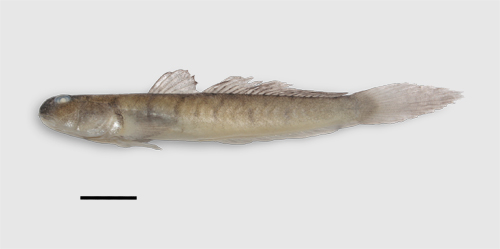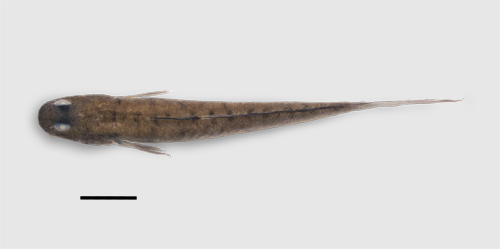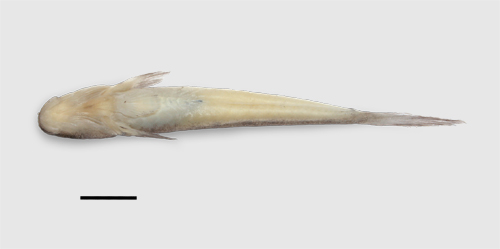Common names:
|
Bangladesh |
Bengali |
chewa bele, chiring, dali chewa |
|
Bangladesh |
English |
gobi |
|
China |
Chinese Mandarin |
棘平牙虾虎魚, 棘平牙鰕虎鱼 (ji ping ya xia hu yu - spined flat-teethed goby) |
|
Finland |
Finnish |
lohikäärmeryömijä |
|
India |
- |
bhato
|
|
Italy |
italian |
saltafango bato*
|
* proposed name
|
|
|
Synonyms:
Etymology:
bato refers to a local Indian name, 'bhato' (Hora, 1934; Murdy, 1989)
|
Maximum recorded length:
141 mm SL (Murdy, 1989)
260 mm TL (Rahman, 1989)
Live colouration (Murdy, 1989):
ground colour dorsally pale green with numerous black speckles, laterally greenish to silvery, ventrally white (original description by Hamilton, 1822, in Murdy, 1989)
Colouration on preservation (Murdy, 1989, pers. obs.: India, Myanmar):
ground colour yellow brown to brown, with 6-7 narrow, darker vertical stripes or dusky blotches on sides in some individuals; fins translucent
Diagnosis (Murdy, 1989):
total elements of D2 21-23;
total elements of anal fin 20-24; head length 21.9-23.9%SL; caudal fin length 22.6-32.9%SL; dorsal fins never contiguous.
The genus is characterised by the presence of small cycloid scales on snout
Diet:
no published study is available
Reproduction:
no published study is available
|
|
Ecological notes:
locally abundant on higher mudflats (Islam et al. 2006)
|
|
|
|
Distribution:
from the east coast of India to Burma; type locality: Ganges Delta, India (Murdy, 1989)
|
Remarks:
this species is apparently extensively farmed and consumed in Bangladesh (Islam et al., 2006). Nonetheless, these authors reported an invalid name: Apocryptes bato (Bleeker, 1874); therefore, their identification should be verified (see also above: Ecological notes).
The diagnostic trait of the presence of scales on snout is shared also by Periophthalmodon schlosseri and Pn. freycineti; in these two later species though the scales are approximately 5 times larger (Murdy, 1989)
|
Photographs of Apocryptes bato:
|
A: a specimen fixed and preserved in 95% ethanol; the bar is 10 mm long (photo: G. Polgar, 2006);
B: a shot of A. bato in aquarium (photo: K. Lim, in
Larson & Lim, 2005)*; C, D: close-ups of A. bato in aquarium (photo: F. Schäfer,
2002); E-J: other shots of A. bato in aquarium; E: an individual buried into the sand; F: a subadult; G: an adult; H: a feeding individual; J: a close-up (photos: H. Horsthemke; fishes collected by Heiko Bleher, Hooghly River estuary, 1993) - * with permission
|
Drawings of Apocryptes bato:
A: cephalic sensory and nasal pores of Apocryptes bato: an = anterior nostril; ao = anterior oculoscapular canal pore;
pn = posterior nostril (modified from Murdy, 1989)*;
B: Apocryptes bato (Hamilton) (Cuvier and Valenciénnes, 1837);
C: Apocryptes batoides Day (Day, 1876);
D: Gobius bato Hamilton (Hamilton, 1822) - * with permission
|







